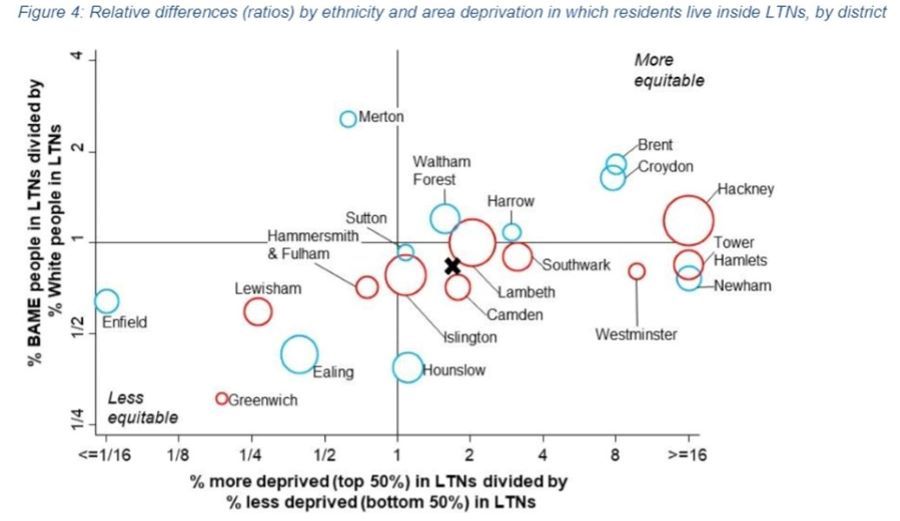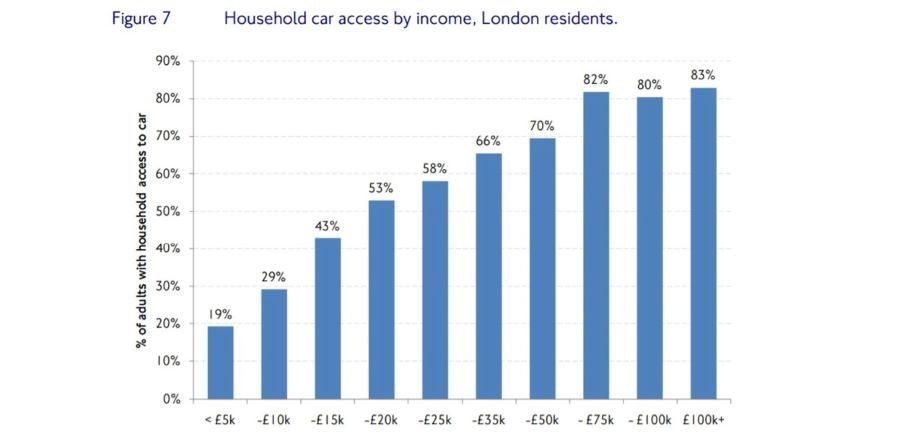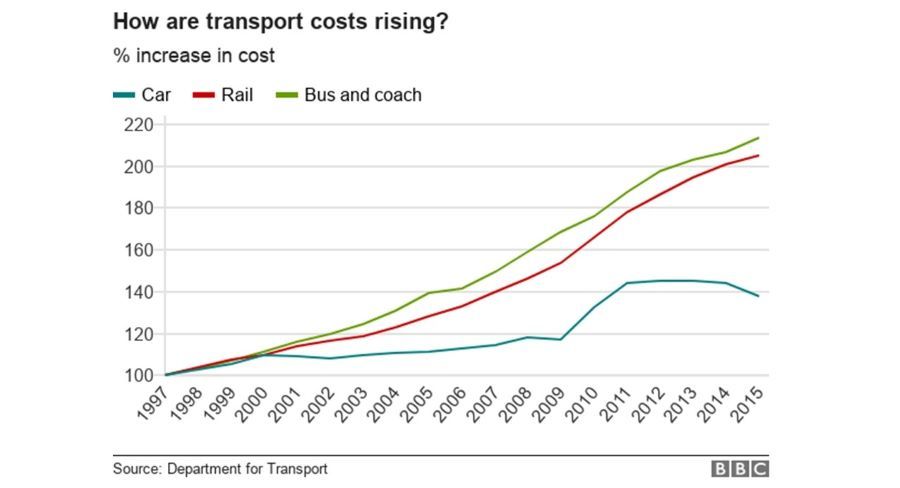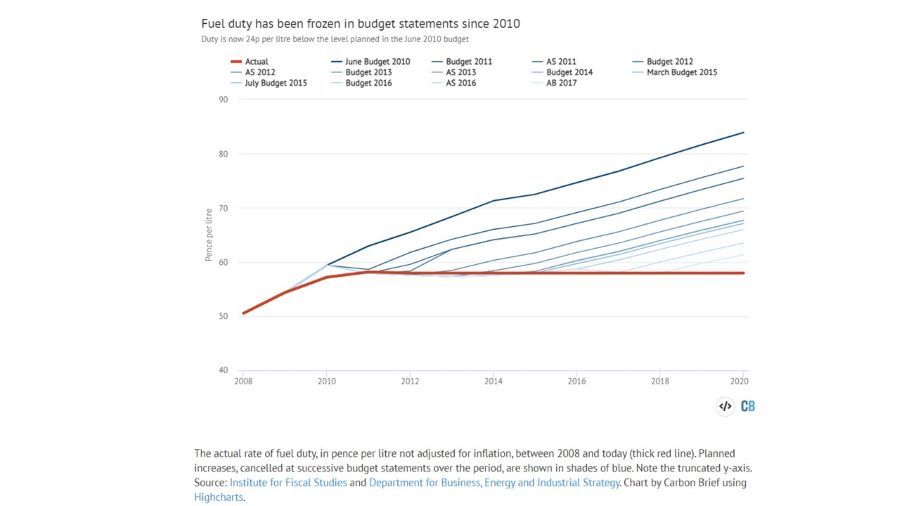LTNs are a beacon of fairness in the transport world's morass of inequity. We have looked into the fairness of: car ownership, fuel duty, car tax, costs of travelling, distribution of the vulnerable. As we researched all this we were reminded of the quotation: "to the one who has, more will be given". But first, the good news…
LTNs are fair
LTNs are good for everyone, and they are also fair, actually, more than fair. This was the conclusion from a 2021 academic study "Equity in new active travel infrastructure". The highlight finding is:
Across London, people in deprived areas were much more likely to live in a new LTN than people in less deprived areas.
The academic study is just that, academic, with lots of tables, but the Guardian report is extremely readable with really informative graphics. It describes the study as:
The most comprehensive study of the rollout so far … which ... uses detailed and sophisticated data to compare streets, including occupants' age, ethnicity, disability, employment and car ownership, and the government's index of multiple deprivation, down to micro-areas of about 300 residents.
and highlights:
Across the city, people in the most deprived quarter of areas were 2.7 times more likely to live in one of the new LTNs than the least deprived quarter of people.
The academic study has one graphic which makes the fairness point very well. With BAME/white up the side and deprived/not-deprived along the bottom, Islington is about as central as it could be:

To see specifically how fair Islington’s LTNs are, we took the Office for National Statistics’ map of Income Deprivation in Islington and overlaid it with the LTN outlines. The results agree with those referenced above: Islington’s choice of locations for the LTNs demonstrates no unfairness whatsoever. See the map here.
We don't know why the Council chose the southern part of the borough for the first few LTNs (Highbury, Amwell, Canonbury East, Canonbury West, Clerkenwell Green, St Peter's) but the Council have committed to deliver 20 LTNs by 2023. Looking at the map we believe this means the whole borough, which is 100% fair.
LTNs are designed so that the boundary roads are those which have always been designated as roads for through traffic. The introduction of LTNs has been shown (after the bedding in period) to reduce the amount of traffic on boundary roads, as well as within the LTNs. (Because fewer motorised journeys are made – see our FAQ about main road traffic for more details). True, traffic is reduced more within the LTN than on the boundary roads but there is no inequity here. Another report examined which people lived on main roads and which on residential roads. The report:
compares four 'protected characteristics' under Britain's Equality Act: age group, income group, ethnic group, and disability status. Across all groups we compared, around nine in ten Londoners live on residential streets.
Any suggestion that only rich people live in residential streets is way off track. People of low income are just as likely as wealthy people to live in a residential road, and so just as likely to benefit from low traffic neighbourhoods.
But inequities do exist and LTNs will help amend some of them - naming a few: lower income families are less likely to have their own outdoor space so their need for usable street space is greater; women, older people and the very young make more local journeys (the school, the shops) than men do; London's black children are more at risk from pedestrian injury than its white or Asian children.
And the traffic world itself is not renowned for fairness:
Car ownership

From TfL (2012) we know that:
- car ownership in Islington is only 26% of households (the lowest of all the boroughs, apart from the City),
- car ownership is highest amongst London residents of white ethnic origin, with car ownership around a third lower amongst black and mixed or other ethnic groups,
- women are less likely to own a car, and
- the young and the old are both less likely to own a car than the middle-aged.
Any facilities provided for people who drive are, and have been for a long time, hugely unfair, privileging the wealthier, whiter, middle-aged man.
Car tax
Some drivers mistakenly think that because they pay "road tax" they have priority on the road over people on bikes or even pedestrians. But, as the BBC points out:
Road tax was abolished in 1937 and replaced by Vehicle Excise Duty. This is a tax on cars, not roads, and it goes straight into the general Treasury fund.
The amount paid depends on how environmentally damaging the car is but £155 seems common. There might be financial fairness, at least, if this amount paid for not just the maintenance of the roads but also the costs of the pollution caused. In 2018 The Independent reported on a study by Oxford and Bath Universities which put the health costs to the NHS and to society at £8,000:
In total, the scientists concluded the health cost of an average car in inner London over the vehicle's lifetime was nearly £8,000. For diesel cars this figure was nearly double.
For each car they own a driver would have to pay the annual car tax 51 times to cover this cost, and 102 times if they drive a diesel car. And that's without fixing a single pothole.
Costs of transport
There is unfairness in the costs of various forms of transport, and it’s getting worse each year. This graph comes from the BBC (the car line is the one at the bottom):

Fuel duty
One factor which has increasingly contributed to the low cost of motoring has been the fuel duty freeze. The LSE and the Grantham Institute reported on this recently, in light of the March 2021 budget:
This points to a Government that is making decisions based on political considerations over the national interest.
This freeze was initiated by Labour so it's an unfairness maintained and increased by both political parties and one that speaks to the power of the motoring lobby.
Carbon Brief points out that:
this rate has been frozen since 2010, meaning motorists have enjoyed a large price cut in real terms, even as public transport fares have risen faster than inflation.
Who is most affected by air pollution
The Mayor of London clearly states:
The most vulnerable groups like children, older people and those with heart and respiratory conditions are most affected. People living in deprived areas are also more affected by poor air quality.
And we know from the evidence above that the young, the old and the deprived are least likely to be drivers. This is the greatest obscenity: those who don’t drive are the most likely to be badly affected by the pollution.

This was made horribly real by the death of Ella Kissi-Debrah. Reported in the Guardian:
A coroner has made legal history by ruling that air pollution was a cause of the death of a nine-year-old girl. He said that her death was caused by acute respiratory failure, severe asthma and air pollution exposure. ... she was exposed to nitrogen dioxide and particulate matter pollution in excess of World Health Organization guidelines, the principal source of which were traffic emissions.
Conclusion
LTNs are fair in themselves and, by discouraging car journeys, they are reducing a long-standing inequity which unfairly privileges drivers.
Sources
Low-traffic schemes benefit most-deprived Londoners, study finds – Guardian March 2021
Council commits to deliver 20 LTNs by 2023 - Islington Gazette March 2021
Roads Task Force - Technical Note 12 – TfL, 2012
Is there any such thing as 'road tax'? – BBC, August 2013
10 charts that tell the story of Britain's roads – BBC, December 2017
Analysis: Fuel-duty freeze has increased UK CO2 emissions by up to 5% - Carbon Brief, March 2020
Health and exposure to pollution – Mayor of London / London Assembly, date uncertain, c. 2017
Air pollution a cause in girl's death, coroner rules in landmark case - Guardian, December 2020








